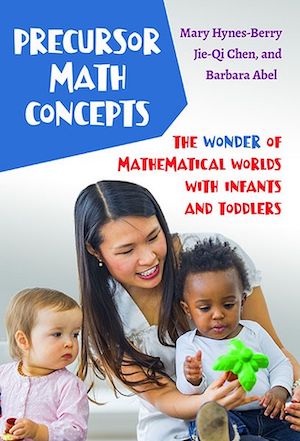Series: Focus on the Child
The CAIR Principle to Tune into Math for Babies and Toddlers

We all know that babies aren’t born walking, talking, following directions, counting, or measuring size. But they do enter the world hard-wired with instincts that will mature and develop into those skills in the preschool and school years. However, that only happens when those mathematical capabilities have been nurtured from the start.
In our Math All Around Me program (MAAM), we associate nurturing with the CAIR Principle. CAIR is an acronym which stands for Closely Attend and Intentionally Respond. This principle guides the way familiar adults interact with babies and toddlers in their care:
- Closely Attend to a child’s gaze, actions, and non-verbal signals such as gestures, pointing, facial expression, and body language. These all are important indicators of children’s current feelings, capabilities, interests, concerns, and needs in all the domains—social-emotional, physical and cognitive.
- Intentionally Respond using positive interactive communication that support babies’ and toddlers’ natural curiosity and their developing ability to make sense of the world around them.
Infant and toddler caregivers don’t need to be instructed about how to use the CAIR principle as such. What they get from the MAAM program is a deeper understanding that math for babies and toddlers is not about drilling numbers and shapes. Rather it is helping the little ones explore and make sense of the many mathematical problem-situations that are built into everyday routines and interactions as well as into play.
However, the strategies they use in their intentional responses must be tailored to where each little one is as they move through the three phases of precursor understanding.
- Emerging Phase (0-14 months) Babies’ sensory-motor systems are still developing. While they don’t talk, they do rely on loving caregivers’ words, gestures, gaze, touch, and interactions to help them recognize and process the sights, sounds, smells, tastes, and textures they are being bombarded with in their immediate environment.
- Developing Phase (12-26 months) Toddlers are developing increasing ability to take actions themselves as well as to use words and other forms of communication to show their thinking. But they still rely on caregivers to step in to take care of their needs as well as to provide opportunities for the toddler to safely explore and make discoveries about quantity and size as well as about issues related to where, when, and what comes next. It is also up to the caregivers to scaffold the toddlers understanding that mathematical thinking is involved in all these issues.
- Transforming Phase (22-36 months) Toddlers’ ability to form mental images, draw on memories and have ideas is growing by leaps and bounds. However, they still depend on caregivers closely attending and intentionally responding to keep them safe and scaffold their thinking about increasingly precise solutions to the math that is all around us.
In all the phases, it is equally the caregiver’s responsibility to respect and draw on the linguistic and cultural funds of knowledge that come from the child’s home environment. At the same time, caregivers recognize and respect that each child follows a unique learning path. The age any individual enters one phase or transitions to the next will vary widely. Progress depends on nurturing.
Reading a book is a natural, nurturing way to have conversations about math for babies and toddlers that is all around us. As you watch these two short clips, notice how each caregiver tailors what they closely attend and intentionally respond to the precursor phase the children are at.
Watch Ms. Dee use a reading of Fuzzy Fuzzy by Sandra Boynton to support a child in the Developing Phase. Her focus, like his, is on identifying sensory attributes.
Here are some things to notice:
- How does Ms. Dee show that she is following the child’s lead as they talk about the book? She pays attention to where he points and to what he is saying. He is at the jargon stage of babble so that while we may not understand his words, Ms. Dee uses the rise and fall of his voice to tell when he is asking a question or making a statement.
- What do you notice about how her tone of voice and the way that she draws out certain words, as well as the way she gently guides his hand makes this a very positive interaction?
Now notice how Ms. Leticia closely attends and intentionally responds to two children in the Transforming Phase. She uses a counting book to carry on a rich conversation that gets them thinking about age and size.
Here are some things to notice:
- Did you notice how Ms. Leticia stops reading the text to use the girls’ interest in the baby instead to guide a rich conversation about age and size?
- What are examples of how she and the children use words as well as gestures and pointing to express themselves?
- What are examples of Ms. Leticia asking questions or re-voicing the girls’ comments to emphasize there are many cues about appearance as well as size that help them understand the complex relationship between size and age?
When caregivers tune into the math all around and the young ones in their care, then no lesson plan is needed! Children’s natural interest in making sense of their world is all that is needed when you closely attend and intentionally respond in a nurturing way.

Precursor Math Concepts: The Wonder of Mathematical Worlds With Infants and Toddlers
This groundbreaking book looks at the development of mathematical thinking in infants and toddlers, with an emphasis on the earliest stage, from zero to three, when mathematical thinking and problem solving first emerge as natural instincts.
Photo by William Fortunato from Pexels